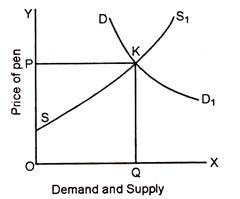The below mentioned article provides short notes on equilibrium of demand and supply.
In the theory of demand and supply no purchaser wants’ to pay as the price of the commodity more than its Marginal Utility.
Similarly, no producer wants to accept the price of the commodity less than its marginal cost. Therefore, the price of any commodity is fixed in between the maximum and minimum limit.
The purchaser wants to pay as less as possible the price of the goods while the seller wants to realise as much price as possible.
ADVERTISEMENTS:
In this way if the purchaser’s side is powerful, then the price will be near the minimum and if the seller’s side is powerful, then the price of the commodity will be near the maximum point. In this connection Prof. Marshall has said that—”The price may be tossed hither and thither like a shuttle-cock as one side or the other gets the better in the haggling and bargaining of the market.”
Thus, demand and supply works opposite to each other. In the end, the point where demand and supply intersect each other and are equal on that point the price is fixed and is called “Equilibrium Price.” Prof. Boulding has written—”The price at which demand and supply are equal is known as an Equilibrium Price, since at this price the forces of demand
and supply are balanced, or are in equilibrium. The quantity bought and sold (or the amount supplied or demanded) at this equilibrium price is known as equilibrium amount.”
If the equality between the quantity demanded and the quantity supplied does not hold for some price, buyer’s and seller’s desires are divergent; either the amount demanded by buyers is more than that offered by sellers, or the amount offered for supply by sellers is greater than the amount demanded by buyers. In either case, the price will change so as to bring about equality between quantity demanded and quantity supplied.
This equilibrium price can be explained by the following table:
Sign indicates balanced point or Equilibrium Point.
From this table it is clear that in Perfect Competition market the price of the pen will be fixed at Rs. 12 because on this price the demand of pen and the supply of pen are equal. Here Equilibrium Price is Rs. 12 and the equilibrium quantity of demand and supply is 30. Further, suppose, if the price of pen comes down to Rs. 8, then the demand for pen will increase and as a result again the price will go to Rs. 12.
On the contrary if the price of pen becomes Rs. 16, then the demand for pen will come down and as a result again the price will reduce to Rs. 12. From this up and down it can be gathered that ‘Equilibrium Price’ may be less or it may be more but its tendency always is to reach the Equilibrium Point.
In the diagram drawn above OX axis shows demand and supply of pen and on OY axis price of pen, arc DD1 shows demand and SS1 shows supply. Arc of demand DD1 cuts supply are at point K. Therefore, the determination of price will be on point K and the price of pen will be KQ. This price will be called Equilibrium Price.

